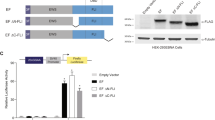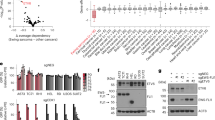Abstract
The chromosomal translocation specifically linked to the Ewing sarcoma family results in the generation of fusion proteins comprising the amino terminal portion of EWS and the DNA-binding domain of ets transcription factors. The EWS/ets chimeric proteins act as aberrant transcription factors leading to tumorigenic processes. We searched for genes specifically activated in Ewing sarcoma cells but not in other tumor cell lines using the gene array technique, and found significantly enhanced expression of the Id2 gene. High levels of Id2 transcripts were detected in Ewing sarcoma cell lines and tumor tissues. The EWS/ets chimeric proteins activated the Id2 gene via the 5′-upstream promoter sequence. Chromatin-immunoprecipitation revealed a direct interaction of EWS/Fli-1 with the promoter regions of the Id2, TGF-β type II receptor, cyclin D1, and c-myc genes. Since EWS/Fli-1 transactivates c-myc, a cooperative action of the chimeric protein and c-myc leads to overexpression of Id2. In the present study, we suggest that Id2 is a target of the chimeric proteins and that the c-myc/Id2 pathway plays a pivotal role in the tumorigenic processes provoked by EWS/ets proteins.
This is a preview of subscription content, access via your institution
Access options
Subscribe to this journal
Receive 50 print issues and online access
$259.00 per year
only $5.18 per issue
Buy this article
- Purchase on Springer Link
- Instant access to full article PDF
Prices may be subject to local taxes which are calculated during checkout






Similar content being viewed by others
References
Bailly RA, Bosselut R, Zucman J, Cormier F, Delattre O, Roussel M, Thomas G and Ghysdael J . (1994). Mol. Cell Biol., 14, 3230–3241.
Benezra R, Davis RL, Lockshon D, Turner DL and Weintraub H . (1990). Cell, 61, 49–59.
Braun BS, Frieden R, Lessnick SL, May WA and Denny CT . (1995). Mol. Cell Biol., 15, 4623–4630.
Dauphinot L, De Oliveira C, Melot T, Sevenet N, Thomas V, Weissman BE and Delattre O . (2001). Oncogene, 20, 3258–3265.
Delattre O, Zucman J, Plougastel B, Desmeze C, Melot T, Peter M, Kovar H, Joubert I, de Jong P, Rouleau G, Aurias A and Thomas G . (1992). Nature, 359, 162–165.
Dudek H, Tantravahi RV, Rao VN, Reddy ES and Reddy EP . (1992). Proc. Natl. Acad. Sci. USA, 89, 1291–1295.
Edelman GM, Meech R, Owens GC and Jones FS . (2000). Proc. Natl. Acad. Sci. USA, 97, 3038–3043.
Gegonne A, Bosselut R, Bailly RA and Ghysdael J . (1993). EMBO J., 12, 1169–1178.
Iavarone A, Garg P, Lasorella A, Hsu J and Israel MA . (1994). Genes Dev., 8, 1270–1284.
Im YH, Kim HT, Lee C, Poulin D, Welford S, Sorensen PH, Denny CT and Kim SJ . (2000). Cancer Res., 60, 1536–1540.
Jeon IS, Davis JN, Braun BS, Sublett JE, Roussel MF, Denny CT and Shapiro DN . (1995). Oncogene, 10, 1229–1234.
Langlands K, Yin X, Anand G and Prochownik EV . (1997). J. Biol. Chem., 272, 19 785–19 793.
Lasorella A, Iavarone A and Israel MA . (1996). Mol. Cell. Biol., 16, 2570–2578.
Lasorella A, Noseda M, Beyna M, Yokota Y and Iavarone A . (2000). Nature, 407, 592–598.
Martinsen BJ and Bronner-Fraser M . (1998). Science, 281, 988–991.
Matsumoto Y, Tanaka K, Nakatani F, Matsunobu T, Matsuda S and Iwamoto Y (2001). Br. J. Cancer, 84, 768–775.
May WA, Arvand A, Thompson AD, Braun BS, Wright M and Denny CT . (1997). Nat. Genet., 17, 495–497.
Moreno CS, Beresford GW, Louis-Plence P, Morris AC and Boss JM . (1999). Immunity, 10, 143–151.
Nelsen B, Tian G, Erman B, Gregoire J, Maki R, Graves B and Sen R . (1993). Science, 261, 82–86.
Neuman T, Keen A, Zuber MX, Kristjansson GI, Gruss P and Nornes HO . (1993). Dev Biol, 160, 186–195.
Noguera R, Triche TJ, Navarro S, Tsokos M and Llombart BA . (1992). Lab. Invest., 66, 143–151.
Norton JD, Deed RW, Craggs G and Sablitzky F . (1998). Trends Cell Biol., 8, 58–65.
Ohno T, Ouchida M, Lee L, Gatalica Z, Rao VN and Reddy ES . (1994). Oncogene, 9, 3087–3097.
Pankov R, Neznanov N, Umezawa A and Oshima RG . (1994). Mol. Cell Biol., 14, 7744–7757.
Paulussen M, Ahrens S, Dunst J, Winkelmann W, Exner GU, Kotz R, Amann G, Dockhorn-Dworniczak B, Harms D, Muller-Weihrich S, Welte K, Kornhuber B, Janka-Schaub G, Gobel U, Treuner J, Voute PA, Zoubek A, Gadner H and Jurgens H . (2001). J. Clin. Oncol., 19, 1818–1829.
Peter M, Couturier J, Pacquement H, Michon J, Thomas G, Magdelenat H and Delattre O . (1997). Oncogene, 14, 1159–1164.
Petermann R, Mossier BM, Aryee DN, Khazak V, Golemis EA and Kovar H . (1998). Oncogene, 17, 603–610.
Seth A, Hodge DR, Thompson DM, Robinson L, Panayiotakis A, Watson OK and Papas TS . (1993). AIDS Res. Hum. Retroviruses, 9, 1017–1023.
Sorensen PH, Lessnick SL, Lopez-Terrada D, Liu XF, Triche TJ and Denny CT . (1994). Nat. Genet., 6, 146–151.
Sugimoto T, Umezawa A and Hata J . (1997). Virchows Arch, 430, 41–46.
Thomas PS . (1980). Proc. Natl. Acad. Sci. USA, 77, 5201–5205.
Thompson AD, Braun BS, Arvand A, Stewart SD, May WA, Chen E, Korenberg J and Denny C . (1996). Oncogene, 13, 2649–2658.
Toretsky JA, Kalebic T, Blakesley V, LeRoith D and Helman LJ . (1997). J. Biol. Chem., 272, 30 822–30 827.
Urano F, Umezawa A, Hong W, Kikuchi H and Hata J . (1996). Biochem. Biophy. Res. Commun., 219, 608–612.
Urano F, Umezawa A, Yabe H, Hong W, Yoshida K, Fujinaga K and Hata J . (1998). Jpn. J. Cancer Res., 89, 703–711.
Wasylyk B, Wasylyk C, Flores P, Begue A, Leprince D and Stehelin D . (1990). Nature, 346, 191–193.
Yokota Y, Mansouri A, Mori S, Sugawara S, Adachi S, Nishikawa S and Gruss P . (1999). Nature, 397, 702–706.
Acknowledgements
The EWS/ERG expression vector are gifts from T Ohno (Gifu University, School of Medicine). We thank T Fukasawa (Keio University School of Medicine) for reviewing this manuscript, and the staff of Department of Pathology, Keio University School of Medicine for technical assistance. We are grateful to K Saito, S Asai, J Osegawa and K Abe for joining this research as undergraduate students.
This work was partly supported by a Grant-in Aid for Scientific Research from the Ministry of Education, Culture, Sports, Science, and Technology, as well as a Grant-in-Aid for Scientific Research from the Japan Society for the Promotion of Science (JSPS).
Author information
Authors and Affiliations
Corresponding author
Rights and permissions
About this article
Cite this article
Fukuma, M., Okita, H., Hata, Ji. et al. Upregulation of Id2, an oncogenic helix-loop-helix protein, is mediated by the chimeric EWS/ets protein in Ewing sarcoma. Oncogene 22, 1–9 (2003). https://doi.org/10.1038/sj.onc.1206055
Received:
Revised:
Accepted:
Published:
Issue Date:
DOI: https://doi.org/10.1038/sj.onc.1206055
Keywords
This article is cited by
-
Therapeutic targeting the oncogenic driver EWSR1::FLI1 in Ewing sarcoma through inhibition of the FACT complex
Oncogene (2023)
-
Inhibitor of DNA binding 2 (ID2) regulates the expression of developmental genes and tumorigenesis in ewing sarcoma
Oncogene (2022)
-
Mut2Vec: distributed representation of cancerous mutations
BMC Medical Genomics (2018)
-
The histone demethylase KDM3A is a microRNA-22-regulated tumor promoter in Ewing Sarcoma
Oncogene (2015)
-
Junction region of EWS-FLI1 fusion protein has a dominant negative effect in Ewing’s Sarcoma in vitro
BMC Cancer (2012)



